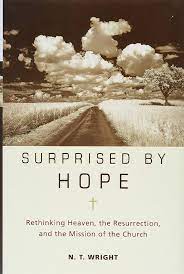ABSTRACT:
Historical Premillennialism holds to the idea of gathering information from the early church fathers as a foundation for understanding Eschatology. This paper primarily outlines the two different forms of Partial Preterism of which Historical Premillennialism is often associated with in direct opposition to Dispensational teachings. Secondly, it seeks to bring clarity to N T Wright position based on his work “surprised by Hope.
Partial Preterism
Partial Preterism is a view that recognizes fulfillment of prophecy in the past and yet it should be recognized that the Olivet and its fulfillment should not be labeled as a last day Eschatological event. Often Partial Preterism is defined in one singular way and care should be taken to distinguish the difference and thus requires a different label. The most common form of PP adheres to these basic premises:
- Early Date of Revelation
- Olivet and the Revelation of John are of the same context and content.
PP differs from Full Preterism in that the Olivet speaks of the second coming which PP disagrees and places the second coming in the future which then creates a world of contradictions and inconsistencies with narrative details of Revelation. This form of PP believes that Rev 1-18 is fulfilled in the events of AD 70.
A more careful examination of the Early Church Fathers lays a groundwork for understanding the Olivet is characterized by the Historical Premillennial paradigm. Premillennialism was the most widely held view in the earliest centuries of the church. Philip Schaff states,
The most striking point in the eschatology of the Ante-Nicene age is the prominent chiliasm, or millennarianism, that is, the belief of a visible reign of Christ in glory on earth with the risen saints for a thousand years, before the general resurrection and judgment. It was indeed not the doctrine of the church embodied in any creed or form of devotion, but a widely current opinion of distinguished teachers, such as Barnabas, Papias, Justin Martyr, Irenaeus, Tertullian, Methodius, and Lactantius.[1]
Premillennialism is the view that, following Christ’s Post-Tribulation return (Revelation 4-18), He ushers in the restoration of the Davidic Kingdom on earth. This view holds that the Tribulation period of the Beast ends with the return of Christ (2 Thess 2:8). The thousand years begin with the complete imprisonment of Satan, during which time he is no longer free to roam the earth, deceiving the nations as he currently does (1 Peter 5:8).
With Christ’s return comes the resurrection of all the saints; they are raised as His army in the first resurrection (Rev 19:14). After the meeting of Christ with the saints in the air, Christ returns to Jerusalem, which becomes the “camp of the Saints,” the capital of the kingdom He establishes on earth (Rev 20:9). This is the restoration of the kingdom to Israel referred to in Acts 1:6–7, at the time set by the Father. At the end of this Millennium, Satan is released to deceive the nations and gathers an army to attack Jerusalem for a second time. Fire comes down from heaven and the ungodly, along with this earth, are burnt up. The Great White Throne Judgment precedes the arrival of the New Heaven and Earth. These are the last events leading into eternity.
The single distinction is made with the obvious conclusions.
- The Late Date of Revelation composition.
If Revelation was written post AD 70 then none of the events listed in the account has anything to do with AD 70. Any reference to Eschatolgical events found in the Epistles are to be harmonized with the Revelation account.
This then makes the Olivet a non-eschatological event concerning the last days events as described with the second coming, concluding with the arrival of the NHE. AD 70 become the last days events concerning Jerusalem and the temple worship system coming to its end.
So the confusion is centered on the idea the Historical Premillennialist (HP) accepts the events of AD 70 as the fulfillment of the Olivet discourse, not for the events of the Revelation narrative. Which does not discount that details in part have a shadow in the events of Revelation just as the events of the Babylonian Captivity has similarities to the events of AD 70. There is one glaring fact; Jerusalem is never destroyed in the narrative of Revelation, in fact Christ returns in defense of Jerusalem. (Zech 12:8 On that day the LORD will protect the inhabitants of Jerusalem… And on that day I will seek to destroy all the nations that come against Jerusalem.)
The HP makes the exegetical argument for this separation based on two arguments, one which NT Wright argues in “Surprised by Hope.”
The first thing to get clear is that, despite widespread opinion to the contrary, during his earthly ministry Jesus said nothing about his return. I have argued this position at length and in detail in my various books about Jesus and don’t have space to substantiate it here. Let me just say two things, quite baldly.
First, when Jesus speaks of “the son of man coming on the clouds,” he is talking not about the second coming but, in line with the Daniel 7 text he is quoting, about his vindication after suffering. The “coming” is an upward, not a downward, movement. In context, the key texts mean that though Jesus is going to his death, he will be vindicated by events that will take place afterward … they certainly include both Jesus’s resurrection and the destruction of the Temple, the system that opposed him and his mission. Wright, Surprised, p 125.
There is no promise of a second coming within the Olivet text and the fatal mistake of many so-called scholars is to try to tie it in with a NT passage such as I Thess 4. Many FP and PP have tried to argue the basis for the Eschatology of the Apostles in the Epistles is based in Mathew’s gospel but failed to realize that Mathew’s gospel was not even written until after 64 AD.
Early Church Father – Anti-Nicene Fathers (ANF)
The first thing the ANF demonstrated in their writing what they believed doctrinally. We have their writing, so we know where they disagreed, and no one is saying that we should believe every word of what they teach. Yes, there were many differences doctrinally BUT, on the essentials, they agreed, there was no differences in what they believed is the Gospel. By mid-300’s they solidified those core doctrines such as the Trinity, Incarnation, and the 66 books of the New Testament, which demonstrates God was providentially involved. They codified these beliefs in a creed to abbreviate what they understood it meant to be a Christian, to give an answer for the hope that lives within them. To separate Christianity from the heresies of the day; Gnosticism, Pelagianism, Arianism, Marcion, Docetism, and Nestorianism.
The second thing that the ANF speak to is concerning historical facts, IF any event was to take place concerning the second coming-NHE would have been experienced by the Christian. There would have been a declaration that all things were fulfilled and yet they testified to several things.
No Early Church Father ever declared that Christ returned in AD 70, (which I know is a Full Preterist position) and in fact the earliest statement made in the Didache[2] declared in its final paragraph.
And then shall appear the signs of the truth first, the sign of an outspreading in heaven; then the sign of the sound of the trumpet; and the third, the resurrection of the dead; yet not of all, but as it is said: The Lord shall come and all His saints with Him. Then shall the world see the Lord coming upon the clouds of heaven.
The disconnect then of the PP position is not addressing the fact that 2 Thess 2:8 and Rev 19:19 both state the beast is killed by the coming of Christ. So it is entirely inconsistent to claim Rev and the beast narrative was fulfilled in AD 70 without the coming of the Lord.
Barnabus reflected a common belief among the ANF :
For He has revealed to us by all the prophets that He needs neither sacrifices, nor burnt offerings, nor oblations, saying thus, What is the multitude of your sacrifices unto Me, says the Lord? I am full of burnt offerings, and desire not the fat of lambs, and the blood of bulls and goats, not when you come to appear before Me: for who has required these things at your hands? Tread no more My courts, not though you bring with you fine flour. Incense is a vain abomination unto Me, and your new moons and sabbaths I cannot endure. He has therefore abolished these things.
This means: when His Son, coming [again], shall destroy the time of the wicked man, and judge the ungodly, and change the-sun, and the moon, and the stars, then shall He truly rest on the seventh day.
The most interesting things is that Barnabaus stated very clearly,
Moreover, He again says, Behold, they who have cast down this temple, even they shall build it up again. It has so happened. For through their going to war, it was destroyed by their enemies; and now: they, as the servants of their enemies, shall rebuild it. Again, it was revealed that the city and the temple and the people of Israel were to be given up. For the Scripture says, And it shall come to pass in the last days, that the Lord will deliver up the sheep of His pasture, and their sheepfold and tower, to destruction. And it so happened as the Lord had spoken.
Barnabus confesses the Temple was destroyed according to the OT prophecies. The fulfillment of the Olivet and yet claims a future second coming and a future “beast.”
In examining what Irenaeus wrote, from the same book and section that centered on the identity of the “antichrist,” Irenaeus made it clear that he understood John lived until the time of Trajan.[3] Irenaeus stated twice previously in the book, “For he remained among them until the time of Trajan”[4] which establishes that John was seen during the reign of Trajan, as Gentry admits.[5]
It is therefore more certain, and less hazardous, to await the fulfilment of the prophecy, than to be making surmises, and casting about for any names that may present themselves, inasmuch as many names can be found possessing the number mentioned; and the same question will, after all, remain unsolved.[6]
This would suggest there is no need to question if what was seen was John or the Revelation of John in the preceding contested quote. By naming Domitian as the time frame in which something was seen would strongly suggest it was the vision and not John since Irenaeus had already established John was seen up to the time of Trajan. If John lived to the time of Trajan who proceeded Nerva, and Domitian, what was being seen nearly in their day would have been the apocalypse and not John himself according to the context of the discussion, which was about the visions of John and not John himself.
In this same chapter of Against Heresies, Irenaeus is presenting his argument and states that,
But now as he was, and is not, and shall ascend out of the abyss, and goes into perdition, Revelation 17:8 as one who has no existence; so, neither has his name been declared, for the name of that which does not exist is not proclaimed.[7]
so that it is implied that Irenaeus believed these Revelation events were all future and not something fulfilled in AD 70. Irenaeus clearly expressed his opinion on the matter of who the Beast was.
From the same source Irenaeus also stated,
He will reign for three years and six months and sit in the temple at Jerusalem; and then the Lord will come from heaven in the clouds, in the glory of the Father, sending this man and those who follow him into the lake of fire.[8]
this places the Revelation account into a future time of fulfillment. At this point in time of Irenaeus’s writing the temple had been destroyed and the sacrifices had ceased along with the nation of Israel. Clearly Irenaeus did not identify Nero or any such person as the Beast in the events leading up to AD 70 or after. Nor is there any claim of Revelation be fulfilled in the events of AD 70. Irenaeus does make the implication that the temple would exist in the future for these predictions of His Coming to be accomplished.
When we come to Eusebius, “History of the Church” Book 3 he states,
It is fitting to add to these accounts the true prediction of our Saviour in which he foretold these very events.
2. His words are as follows: Woe unto them that are with child, and to them that give suck in those days! But pray that your flight be not in the winter, neither on the Sabbath day. For there shall be great tribulation, such as was not since the beginning of the world to this time, no, nor ever shall be.
These things took place in this manner in the second year of the reign of Vespasian, in accordance with the prophecies of our Lord and Saviour Jesus Christ, who by divine power saw them beforehand as if they were already present, and wept and mourned according to the statement of the holy evangelists, who give the very words which he uttered, when, as if addressing Jerusalem herself, he said:
And then, as if speaking concerning the people, he says, For there shall be great distress in the land, and wrath upon this people. And they shall fall by the edge of the sword and shall be led away captive into all nations. And Jerusalem shall be trodden down of the Gentiles, until the times of the Gentiles be fulfilled. And again: When you shall see Jerusalem compassed with armies, then know that the desolation thereof is near.
7. If anyone compares the words of our Saviour with the other accounts of the historian concerning the whole war, how can one fail to wonder, and to admit that the foreknowledge and the prophecy of our Saviour were truly divine and marvelously strange.
Eusebius follows this up by quoting from Josephus. Then states very clearly,
Domitian, having shown great cruelty toward many, and having unjustly put to death no small number of well-born and notable men at Rome, and having without cause exiled and confiscated the property of a great many other illustrious men, finally became a successor of Nero in his hatred and enmity toward God. He was in fact the second that stirred up a persecution against us, although his father Vespasian had undertaken nothing prejudicial to us.
It is said that in this persecution the apostle and evangelist John, who was still alive, was condemned to dwell on the island of Patmos in consequence of his testimony to the divine word.
But after Domitian had reigned fifteen years, and Nerva had succeeded to the empire, the Roman Senate, according to the writers that record the history of those days, voted that Domitian’s honors should be cancelled, and that those who had been unjustly banished should return to their homes and have their property restored to them.
It was at this time that the apostle John returned from his banishment in the island and took up his abode at Ephesus, according to an ancient Christian tradition.
It’s hard to argue for the early date when the testimony of the ANF is for the late date and the ANF are consistent in these facts that it did not take pace.
Conclusion
So what we find among the ANF is a consensus of facts. Namely there is no declaration that a second coming took place but more importantly no beast. Then the Olivet was fulfilled in those events of AD 70. The Revelation account is still future even to us today.
[1] Phillip Schaff, History of the Christian Church, Volume II: Ante-Nicene Christianity. A.D. 100-325 (1882) Third Ed., Revised Electronic Bible Society, Public Domain, 2002-11-27 (Grand Rapids: Christian Classics Ethereal Library, 2002), 381.
[2] The Didache is the earliest church writing after AD 70, that was nearly accepted as “inspired” work, written somewhere between AD 70-120.
[3] Irenaeus, Against Heresies, 2.22.5.
[4] Irenaeus, Against Heresies, 2.22.5.
[5] Irenaeus, Against Heresies, 3.3.4 has John living until the time of Trajan.
[6] Irenaeus, Against Heresies, 5.30.3.
[7] Irenaeus, Against Heresies, 5.30.4.
[8] Irenaeus, Against Heresies, 5.30.4. This also supports the historical premillennial view.







Leave a Reply